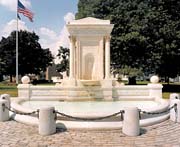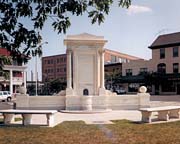
The John Haynes Lord Memorial Fountain in Somerville, NJ, was erected in 1909 to honor Lord, president of the Second National Bank of Somerville and a well-known town citizen. His sister requested that the monument be a drinking fountain for "man and beast" in memory of her brother.
Original architect John Russell Pope designed the fountain to emulate a Roman monument, and chose a lion's face to depict the "beast" portion of the fountain, with a stone sculpture of the face on one side and a bronze plaque of it on the other. He then selected Vermont marble to be used for the shaft of the fountain, while pink granite was used for the base, basin walls and bollards. A large basin with bronze chains was placed in the front for horses, while the backside of the fountain had a water fountain for people. Once designed, the fountain was placed in front of the Somerset County Courthouse.
After some years of use, the fountain had become non-operational for decades. Because of the prominent location of the fountain, the people of the county recently wanted to have it repaired. The architects of Ford Farewell Mills & Gatsch in Princeton, NJ, were commissioned to restore the fountain. "After it originally worked, the county stopped using it as a fountain, and decided to use it as a planter," said Christa Gaffigan, project architect of Ford Farewell Mills & Gatsch. "Then they stopped using it as a planter, and it really became deteriorated over time."
The goal for the restoration of the fountain was to bring it back to functioning, install new plumbing without dismantling it, create a larger vault space to house the new fountain equipment and restore and repair the existing marble, granite and concrete. The marble and granite had been stained, and some carved stone was lost over the years.
In order to clean the stone, workers from Paragon Restoration Corp. of Kenilworth, NJ, used various ProSoCo cleaning and restoration products. While the granite and marble were both chemically cleaned, some portions of the marble needed a different cleaning method. "We used a micro-abrasive cleaning method on the marble's dentil area on top of the fountain," said Mike Papio of Paragon Restoration. "Any regular chemical would have taken the dentils right off the stone, so instead we consolidated the area first, then performed the microabrasive method afterword. It was very time consuming, but it worked well."
The whole cleaning and restoring process took Paragon Restoration about eight months to complete. "We began in late fall, and stopped in the winter because of the cold temperatures," said Papio. "Then we re-started in the spring and finished the project."

Once the stone lion's head was completed, a bronze lion head plaque was made as an exact duplication of it, to be placed on the other side of the fountain. A bronze sculptor, using the broken stone lion head as a model, recreated this plaque. Bronze chains were then reinstalled between the granite bollards to replicate the original chains, which were also missing.
Aside from the restoration of the stonework, the fountain's plumbing system was refurbished to gain back the fountain's original function. "A 6-inch core was drilled vertically from the top of the fountain straight down into the existing vault, to give space to re-plumb the fountain," said Gaffigan. "A new, more spacious underground vault was then built and connected to the existing vault to get the fountain working again." Completed in August 2000, the restored fountain has been well received by the community. "Because of its prominent corner location, everyone was very enthusiastic about having the fountain restored," said Gaffigan. "The people of the county really enjoyed it and a lot of people turned out for the rededication."